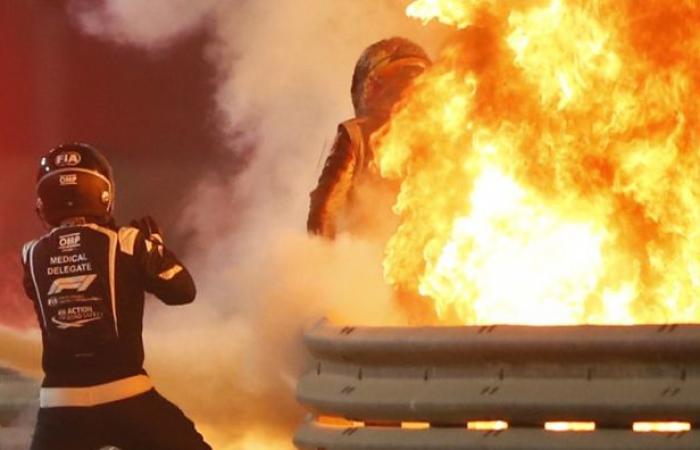Romain Grosjean miraculously managed to escape alive from his split in half and on fire after crashing at the start of the Bahrain Grand Prix. But what exactly has ensured that he got off well under the circumstances?
Formula 1 has invested heavily in recent years in making the sport safer for drivers. The most recent example is the introduction of the halo, an extra protection for the drivers head in particular. The halo also played a crucial role in Grosjean’s crash, but there are four more things that saved his life.
Halo protection
The biggest savior in the crash of Grosjean, as mentioned, was the halo. It is likely that the outcome of the crash would have been different without the presence of this component. The central pillar in his design appears to have played a vital role in saving his life, effectively separating the barriers above his head as his car speeded through the metal. The halo not only protected Grosjean’s head from impact, but it also kept him from being knocked unconscious, giving him the opportunity to get out of the car himself.
Driver extraction
The regulations require teams to design their cars in such a way that drivers must be able to get out within five seconds. Considering they are clamped tightly in the cockpit, this is quite a requirement, as the headrest, the HANS device, the radio connections and the drinking hoses all limit the driver’s freedom of movement. Add to that the halo above their heads and it’s not easy to escape. Drivers participate in extraction tests at the beginning of each season, but every part of that operation has to work perfectly and given Grosjean’s speed of extraction, it seems they did in this case.
Auto separation
The chassis is known as the ‘survival cell’ and is designed to be rock solid. It can withstand the equivalent weight of a double-decker bus and is designed to prevent anything from going through the sides. Other parts mounted on it, such as the nose and sidepod crash structures, are designed to crumple to absorb the g-forces in a collision. Crucially, the entire rear of the car is designed to separate from this section in a severe collision. This happened exactly with Grosjean’s crash.
Fireproof clothing
Drivers wear multiple layers of Nomex fire resistant clothing and carbon fiber helmets that contain fire resistant materials. From socks, gloves, a balaclava to full overalls; the protective clothing must withstand temperatures of 800 degrees Celsius, resist ignition for 10 seconds and limit the interior to a maximum of 41 degrees Celsius for 11 seconds. Drivers also wear biometric gloves that provide feedback on heart rate and blood oxygen levels. There is also an accelerometer in the ear that measures the forces acting on their heads. Given his time on the fire, it is thanks to these garments that Grosjean suffered only minor burns from the incident.
Medical Car
It is precisely for this reason that the Mercedes medical car is at the back of the grid at the start of every race. Driver Alan van der Merwe and Dr. Ian Roberts were the final piece of the safety puzzle in the Grosjean incident. They were on the scene almost immediately and set fire to fire extinguishers to save Grosjean. Their skills, training and knowledge ensured that Grosjean not only escaped from the gruesome scene, but was also carefully protected and transferred quickly and efficiently to the hospital.
These were the details of the news These five things saved Grosjean’s life in Bahrain for this day. We hope that we have succeeded by giving you the full details and information. To follow all our news, you can subscribe to the alerts system or to one of our different systems to provide you with all that is new.
It is also worth noting that the original news has been published and is available at news1.news and the editorial team at AlKhaleej Today has confirmed it and it has been modified, and it may have been completely transferred or quoted from it and you can read and follow this news from its main source.

